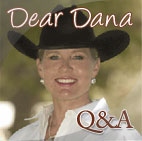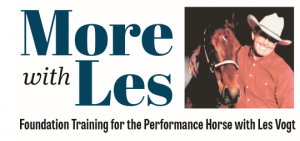 Les gave us last issue a primer on developing your horse’s movement. Now we get into the details of Exercises 3 and 4.
Les gave us last issue a primer on developing your horse’s movement. Now we get into the details of Exercises 3 and 4.
The Brace Rein
Remember how you used your rein to move the horse’s shoulders? First making light contact for bend, then lifting your hand and moving over to direct the shoulders? Well the brace rein is the same concept, except rather than using it to move the horse’s shoulders, you’re just asking him to keep them out of the movement by just maintaining a slight bend with his neck. Whenever you are using the brace rein, you want to make sure that your other rein is way away from the horse’s neck.
Right approach can overcome insecurity, confusion
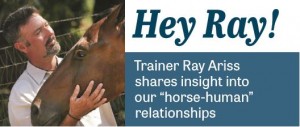 HEY RAY! I sent my 5 yr old Thoroughbred gelding to a local trainer for 30 days to put some leg aids on him. Before he left, he didn’t know his leads but I could canter him in both directions with no problems. When I got him back I saw the trainer do leg yields and canter him on the correct leads but he seemed a little on the muscle and worried. I’ve had him at home for a month now and even though he doesn’t fight, he seems to lose his mind anytime I think of using my legs for anything. What happened? Can you help me? —Lisa Martinez, Scottsdale, Ariz
HEY RAY! I sent my 5 yr old Thoroughbred gelding to a local trainer for 30 days to put some leg aids on him. Before he left, he didn’t know his leads but I could canter him in both directions with no problems. When I got him back I saw the trainer do leg yields and canter him on the correct leads but he seemed a little on the muscle and worried. I’ve had him at home for a month now and even though he doesn’t fight, he seems to lose his mind anytime I think of using my legs for anything. What happened? Can you help me? —Lisa Martinez, Scottsdale, Ariz
Stand still: Patience is key in good training
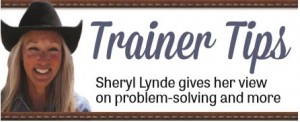 Each horse that comes to me for training teaches me something. As I approach every new horse, I bring my breadth of experience, but also leave a space open to learn. I am receptive to new ideas without any preconceived judgements as to how I can bring out the best in this horse.
Each horse that comes to me for training teaches me something. As I approach every new horse, I bring my breadth of experience, but also leave a space open to learn. I am receptive to new ideas without any preconceived judgements as to how I can bring out the best in this horse.
How much pressure can I use until I get the desired response? How much time can I work on one particular exercise before their resistance turns to frustration and they cease to try? Are they fearful, aggressive, disrespectful? Have they been given enough time to learn the exercise?
There is one consistent theme that I have discovered as a common thread with each horse and that is: Take it slow.
Muscle memory and your horse’s entire body
37th in a series
 Last issue, Les really dialed us into yielding and bending to either side in a willing, balanced manner. As we head into Exercises 3 and 4 in Les’s program, here’s some items to focus on.
Last issue, Les really dialed us into yielding and bending to either side in a willing, balanced manner. As we head into Exercises 3 and 4 in Les’s program, here’s some items to focus on.
Objective:
• To start teaching your horse to let you move his whole body laterally
• To start teaching your horse to let you move his hip
• To learn to do both of these things without letting the shoulder lead the movement
• To improve your back-up or overcome resistance if you’re having problems
• To learn to feel whether your horse is straight from head to tail and learn how to correct him if he is not
• To learn how to back your horse easily and softly
Q&A – Hey Ray!: Let’s put a halt to confusion about the ‘half-halt’
 HEY RAY! I’ve ridden over 20 years under several trainers, and they all have used a term that I am embarrassed to admit that I don’t know—a “half-halt”. What is this, and how do we apply it? —Anonymous rider, San Diego, Calif
HEY RAY! I’ve ridden over 20 years under several trainers, and they all have used a term that I am embarrassed to admit that I don’t know—a “half-halt”. What is this, and how do we apply it? —Anonymous rider, San Diego, Calif
DEAR A.R.: Your situation is a lot more common than you think. You would be surprised how many riders have confided in me that exact same question over the years. This is a topic that I actually like to explain and talk about. Once you have the right visual, it’s a very helpful and effective tool in helping with balance and self carriage.
When we think of the word halt, the picture we usually see is immobility or “freeze.” The purpose of halting is to bring all movement to a complete stop. A half-halt is exactly the opposite of a halt, but it is not a half-hearted halt or kind of halt. The halfhalt has a very specific purpose—to possibly stop, if necessary as an adjustment, with the intention of continuing to move forward.
Reverse Arc: Leading with the shoulder
36th in a series
 Once your horse is moving his shoulders on a diagonal line both ways (without much work or effort on your part or his), we’ll add to the level of difficulty by asking him to actually step around in a circle with his shoulder leading—a movement commonly referred to as the reverse arc.
Once your horse is moving his shoulders on a diagonal line both ways (without much work or effort on your part or his), we’ll add to the level of difficulty by asking him to actually step around in a circle with his shoulder leading—a movement commonly referred to as the reverse arc.
You’ll want to start as you have in the past, however, now you will tighten up the cues even more until you start doing about a 30-foot circle instead of just your diagonal line. At first a quarter circle is fine, then a half, and finally the horse should be able to continue this way as long as you ask him to. One of the great things about this exercise is that as you go around, you are actually teaching the horse to step across with his front legs, just like he will do in the turnaround. Only now, with the reverse arc, you have much more control of his shoulders.
Timing is everything, especially with fearful horses
 The fearful horse’s progression into becoming a more confident mount depends on the timing of your release, not pressure. This goes without saying for any horse, but it’s most crucial in the fearful horse. Why? Because the fearful horse isn’t as forgiving, and a hole in your training is much more apt to produce a dangerous behavior.
The fearful horse’s progression into becoming a more confident mount depends on the timing of your release, not pressure. This goes without saying for any horse, but it’s most crucial in the fearful horse. Why? Because the fearful horse isn’t as forgiving, and a hole in your training is much more apt to produce a dangerous behavior.
Whoa! Is the most important word a driving horse knows
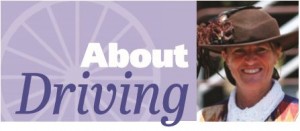 Every time I work with a new horse, I learn something. After getting to know the horse in the round pen, the first things I teach the horse is to walk, whoa , and to stand on command.
Every time I work with a new horse, I learn something. After getting to know the horse in the round pen, the first things I teach the horse is to walk, whoa , and to stand on command.
This introductory part of training is very important for building trust and mutual respect between horse and trainer. Time and patience is needed. Nothing will be gained if the trainer loses his patience and the horse gets frightened or resistant.
WHOA is the most important word a driving horse needs to know. It’s never used in driving to slow a horse — it means STOP all movement. Stand is the next important word your horse must learn. You stop at the stop sign, but the horse must stand until asked to move forward!
 After an overview last issue on isolation and control of your horse’s shoulders, Les gets into detail in Exercise No. 2.
After an overview last issue on isolation and control of your horse’s shoulders, Les gets into detail in Exercise No. 2.
On our first shoulder exercise, we started in small circles and then moved his shoulder into the opposite direction of your circle, keeping the neck soft with no resistance. Now, let’s go through the sequence of exercise number two, moving the shoulder to the right:
Shoulder control: Departures and lead changes
34th in a series
 After focusing on the head and neck with lateral and vertical flexion, Les takes us now into control of the shoulders.
After focusing on the head and neck with lateral and vertical flexion, Les takes us now into control of the shoulders.
Our objective in these exercises is to learn to isolate and control your horse’s shoulders. As with all these exercises, the effectiveness of your hand and leg cues will continue to improve and get more subtle, and you will learn to guide your horse and change direction by moving only his shoulders.
Although no maneuver is initiated with a shoulder, there are many where it is critical to keep the shoulder out of the way. By learning to control the shoulder, you are learning how to keep it out of the way too. Specific maneuvers that this apply to are departures and lead changes.
Another common problem that requires shoulder control is when a horse tries to “drop a shoulder” or lean into his circles. We’ll cover this in future lessons, but you’ll need shoulder control to fix it. Shoulder control is also a fundamental part of creating pretty “shoulders up” circles and stops.


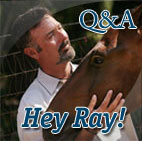
 Read Columns
Read Columns
